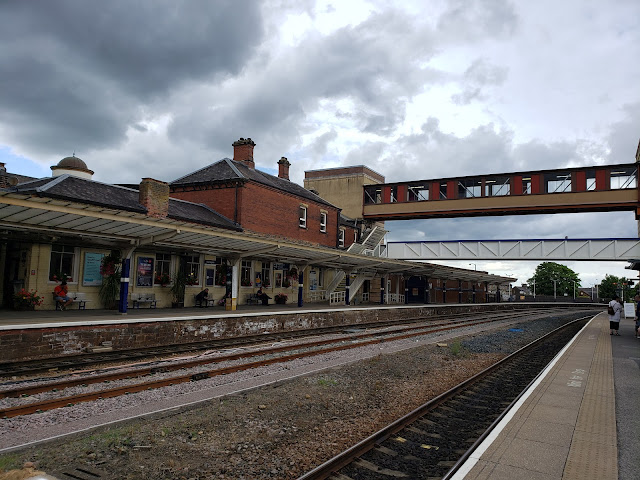Harrogate
 |
| Harrogate Train Station |
I read a lot of Jane Austen during my scholarly quest to
obtain an English Literature degree. In Jane Austen’s novels, Harrogate was where
the refined would go to escape the hustle and bustle of the city and live at a
slower pace. There were dances, social gatherings, and promenades down the wide
streets. I idolized and dreamed of such a place – where life slowed down, and there
were no cares in the world. So when I discovered that Harrogate was less than two
hours by train from Grasscroft (where I was staying in the U.K.), I purchased
my ticket (£26,10 round-trip – about $30 at the time of purchase) and headed out
on a lovely Thursday morning.
In 1858, Charles Dickens described Harrogate as “the queerest
place with the strangest people in it, leading the oddest lives of dancing,
newspaper-reading, and table d’hôte[1].”
Harrogate found its draw in the “healthy” waters bubbling up from over 100 wells.
There are sulfur wells[2],
magnesia wells[3], and
chalybeate[4]
wells. Partaking of the waters was prescribed and thought to have remarkable
healing properties – if the patient didn’t get sick from the smell or taste of
the waters. To avoid a gag reflex, it was recommended to shoot the prescribed
amount of water, much as you would a shot of liquor. I don’t know about you, but
that doesn’t sound appealing at all! I did not try the waters – I doubt I would’ve
made a very good patient during the Romantic or Victorian eras – at least, not
if taking the waters was part of my routine. I’m pretty sure I could knock dancing,
newspaper reading, and eating out of the park, though!
 |
| Harrogate War Memorial |
A little before noon, Harry bounded up to the meeting spot and introduced himself. While waiting for others to join us, he talked with each of us, making an effort to learn our names and where we were from. I was impressed with his ability to ease each of us into conversation, not only with him but with other tour-goers as well.
 |
| Harry explains the Sulfur Well. |
As we walked along to various locations in town, I imagined myself strolling down Parliament Street and stopping in at Betty’s Tea Shop. I could see myself lingering in the Stray, a 200-acre public space beautifully landscaped, enjoying a stroll along the creek fed by the wells or enjoying a picnic lunch on a hill overlooking the city. I have already forgotten the little jewels of knowledge Harry so carefully prepared but what I do have from my time with Harry is an understanding of how Harrogate came to be and why the citizens are proud to call it home.
 |
| Betty's Cafe - Established 1919 |
[1]
Table d’hôte – a multi-course meal offered at a fixed price with a few choices for
each course. Literally translated to “table of the host.”
[2]
Sulfur has antibacterial effects against the bacteria that causes acne, and it
was believed to help individuals with various skin conditions, arthritis,
internal disorders, and digestive disorders.
[3] The
magnesia well contains mild sulfur water and was believed to be a powerful
diuretic.
[4] Chalybeate is a natural mineral spring that contains iron salts. Chalybeate was used to treat “delicate and anemic” patients.
[5] A Blue Badge Tour Guide has completed an intensive course in tourism and has received accreditation from the Institute of Tourist Guiding.
 |
| Royal Hall - opened 1903 |
 |
| Turkish Baths - opened July 1897 |
 |
| Found in the Valley Gardens, a part of the Stray |
 |
| Originally a school - built in 1873 |
 |
| Hales Bar - the oldest pub in Harrogate, originating mid-18th century |




Comments
Post a Comment